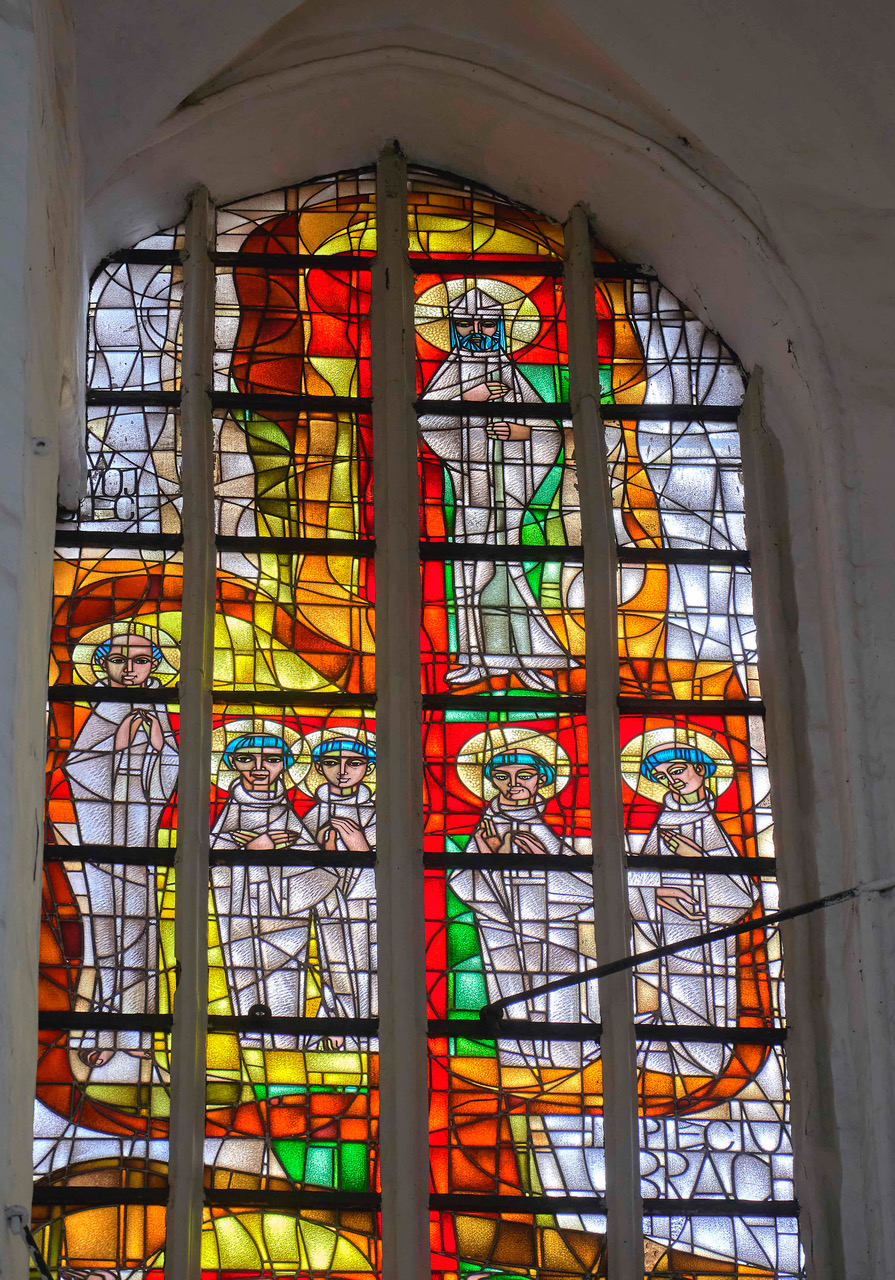Ikonografia witraży Wiktora Ostrzołka w gdańskim kościele Mariackim (1977–1980)
DOI:
https://doi.org/10.26881/porta.2021.20.09Słowa kluczowe:
sztuka sakralna, witraż, Milenium Chrztu PolskiAbstrakt
In 1966, a commemorative decoration appeared inside St Mary’s Church in Gdansk: its main component was the painting showing Poland’s Baptism placed in the chancel. Meanwhile, a pillar by the Priests’ Chapel was decorated with a standard bearing striped concentration camp uniform cloth with numbers of priests-prisoners in Nazi camps. This referred directly to the décor of the Priests’ Chapel created not long before, and in which Polish priests murdered during WW II had been commemorated in 1965. Thus the millennial decoration of the chancel clearly associated the history of the Polish state with the history of Christianity in Poland, while the decoration of the Priests’ Chapel emphasized the martyrology of Polish priests. Both motifs were clearly continued in two large–size stained glass windows installed in the church in the late 1970s: one of them fills in the window in the Priests’ Chapel, while the other is to be found in the window closing the church’s chancel. Both were designed by Wiktor Ostrzołek, a leading stained glass designer in post-WW II Poland.
The iconographic programme of the first refers to the martyrology of priests, yet it does not limit itself to priests-martyrs in recent history, but shows those connected with it from the very beginning: St Adalbert, Five Martyr Brothers, St Stanislaus, St John Sarkander, St Andrew Bobola and Maximilian Kolbe. Respective figures are interconnected with the use of a clear red line serving as a metaphor of the martyrs’ blood. Its continuity connecting St Adalbert with St Maximilian, thus the beginnings of the Polish state with the present, at the same time shows the continuity of the presence of the Catholic Church in Polish history.
This continuity is even more unequivocally expressed by the iconographic programme of the chancel stained glass. Here it is the figure of Mary that stands out; she enshrouds the presentations referring to the Church’s mission, and in particular to the Church’s mission in Poland, in her protective mantle. A deep interconnection between the history of Poland and the Roman Catholic Church was presented in the three acts of entrusting Poland to God and Mary: the Baptism of Poland in 966, the Lvov Oath of John Casimir in 1656, and the Jasna Góra Pledge connected directly with the 1966 millennial celebrations.
Downloads
Bibliografia
Bielak Jacek, Nowoczesność w strefie sacrum. Dekoracje milenijne w kościele Mariackim w Gdańsku [w:] Nowoczesność w sztuce i w myśli o sztuce na Pomorzu od XIX do XXI wieku, red. Jacek Bielak, Józef Tarnowski, Gdańsk 2015, s. 219–251.
Bielak Jacek, Von der „Priester-Kapelle” bis zur „Kapelle der Seeleute”. Die maritime Identität Danzigs am Beispiel der Innenausstattung der Danziger Marienkirche [w:] Die Maritime Stadt – Hafenstädte an der Ostsee vom Mittelalter bis in die Gegenwart. Beiträge der 21. Tagung des Arbeitskreises deutscher und polnischer Kunsthistoriker und Denkmalpfleger in Gdańsk 18–21 September 2013 / Miasto nad morzem – miasta portowe nad Bałtykiem od średniowiecza do współczesności. Materiały 21 konferencji Grupy Roboczej Polskich i Niemieckich Historyków Sztuki i Konserwatorów Zabytków w Gdańsku 18–21 września 2013, red. Tomasz Torbus, Katarzyna Anna Wojtczak, Warszawa 2017, s. 474–486.
Bogdanowicz Stanisław, Dzieła sztuki sakralnej Bazyliki Mariackiej w Gdańsku, Gdańsk 1990.
Gucewicz Daniel, Próba sił? Rok 1966 w Gdańsku. Milenium kontra Tysiąclecie, Gdańsk 2014.
Hałagida Igor, Pomorze Gdańskie [w:] Milenium czy Tysiąclecie, red. Bartłomiej Noszczak, Warszawa [2006], s. 237–251.
Lincer Katarzyna, Malarstwo monumentalne w twórczości Barbary Massalskiej na terenie Trójmiasta, Gdańsk 2014 (praca licencjacka napisana w Instytucie Historii Sztuki UG pod kierunkiem Jacka Friedricha).
Noszczak Bartłomiej, „Sacrum” czy „profanum”? – spór o istotę obchodów Milenium polskiego (1949–1966), Warszawa 2002.
Pyka Henryk, Witraże Wiktora Ostrzołka. Pięćdziesiąt lat twórczości, Katowice 2006.


 Uniwersyteckie Czasopisma Naukowe
Uniwersyteckie Czasopisma Naukowe



